#gas giants
Note
please please please PLEASE share more on your Thoughts about gas giants!! i'd love to learn in a way that doesnt leave me baffled and half my brain leaking from my ears! you explained things so well in the psyche post and also i think things are generally more fun to learn from someone who is Excited To Share than from Published Research Papers where everything has been dried out For Professional Reasons- understandably so, mind, but i am not In The Field and dont know the terms lol
Okay it's taken me forever to get back to this but I AM SO GLAD YOU ASKED.
Like other planets, it all starts with a disk made of gas and dust orbiting an infant star, called a protoplanetary disk. Like these in the Orion Nebula, discovered by the Hubble!

To form terrestrial planets (rocky planets with relatively thin atmospheres like Mercury, Venus, Earth, and Mars), the gas in the protoplanetary disk coalesces to form hundreds and hundreds of rocky bodies called planetesimals, about a kilometer across. These planetesimals collide, and form dozens of protoplanets about the size of the moon. The protoplanets then collide as well, and stabilize to form the solar system as we know it today.
But, in the case of gas giants, colliding protoplanets don't form fully-finished planets. Instead, they form a core, or a seed.
We think the only thing that determines whether a planet will be terrestrial or a gas giant is simply how far away from the sun it forms - that's it. As a new sun warms its evolving solar system, it heats up the material in the protoplanetary disk. Close to the sun, the disk gets hotter, and things like water and other ices melt and evaporate into gas, making them difficult for the protoplanets to gravitationally capture. However, further away, the icy compounds stay cold enough to remain solid and coalesce along with rocky particles.
That boundary in the solar system - where ices evaporate to gas on the sunward side, and remain solid on the other - is called the "Frost Line". In our solar system, the Frost Line is right between Mars and Jupiter.

The protoplanets that form past the Frost Line turn into gas giant seeds, and are able to (kinda literally) snowball, picking up both rocky and icy material. With all that solid ice available, they grow far larger and far faster than planets in the inner solar system, and their gravity gets stronger and stronger. More gravity causes them to collect even MORE material until they're heavy enough to capture extremely lightweight elements like hydrogen and helium. Which, of course, makes them get even bigger and even heavier! Runaway growth!
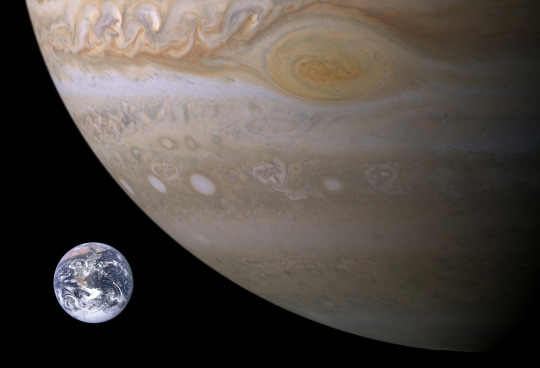
But weirdly, as we study more exoplanets (planets that orbit stars other than our sun), we keep finding these huge gas giants incredibly close to their stars! Like, even closer than Mercury is to ours, which is insane. These "Hot Jupiters" break so many rules - gas giants "should" only be able to form where ice stays frozen, but here they are up close and personal with their stars, like this artist's concept!

It's possible that these planets are in the process of migrating closer to their stars, and we're managing to see them before they evaporate, but we just! Keep! Finding them!
One of my favorite parts of planetary science is how much we still have to learn. We'll think we have a pretty good idea of how things work out there, and then suddenly we'll find something that we can't explain. And there's an entire universe of weird shit - we've barely begun to scratch the surface!
#space#planets#jupiter#gas giants#astrophysics#planetary formation#Hubble#spost#asked and answered#anxiousdemifaemess#it's crazy though#in the early solar system about 98% of the material in the protoplanetary disk is hydrogen and helium#which is so lightweight it's entirely unavailable for planetary formation#it never coalesces and eventually just blows away#or gets eaten by the star#gas giants are able to utilize even a tiny fraction of that material#which is why they get so big!#The Frost Line is the reaso all our gas giants are far away and why we don't see rocky planets like mars hanging out past Jupiter and Satur#Or rather it would be#IF HOT JUPITERS WEREN'T EVERYWHERE RUINING THAT THEORY
143 notes
·
View notes
Text
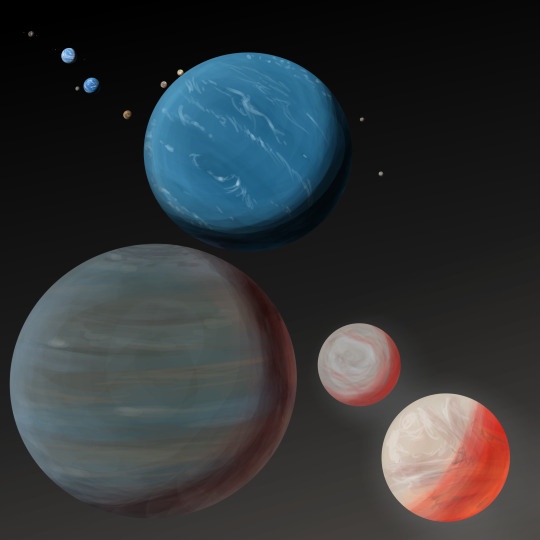


Losar System
Cooking the Solar System from the Inside Out
(yeah lol it does kinda look like it says Loser)
For this system layout, I have taken the Solar System planet's orbital distance in astronomical units, and taken the reciprocal.
The major planets, in order of increasing distance from Los, are Enutpen, Sunaru, Nrutas, Retipuj, Sram, Thrae, Sunev, and Yrucrem.
Read more about them below the cut:

The Losar system formed through a very different mechanism to our solar system. I'm not sure entirely about the specifics, but the arrangement is not dissimilar to the Kepler-90 system, in which 6 super-earth-mass planets are extremely compact and close to their parent star, with a low-mass and a high-mass gas giant at the outer part of the solar system. Perhaps as Retipuj formed, it migrated inward, carrying with it the ice and gas necessary to form the super-earth-mass planetary cores which accreted into Enutpen and Sunaru, or perhaps there was some kind of switcharoo where the Hot Ice Giants started out on more distant orbits, before crossing orbits with Retipuj and then being coralled into lower orbits.
Either way, some kind of migration is necessary, since Enutpen and Sunaru are volatile-rich, and the outer planets are comparatively volatile-poor.
I've excluded Pluto (or "Otulp") and the other dwarf planets, not because I don't like them or think they count as planets, but because I think by the time you're accounting for every large object in the Solar system in the Losar system, it just gets really implausible. also I bet some objects end up inside of the Sun. Plus, this kind of thought experiment is playing the same kind of planetary dynamics game that splitters are playing when they say Pluto's not a planet. Suffice to say, there are definitely lots of interesting small worlds in the Losar system, but they don't have 1:1 analogues with Solar system planets.
There are only five large moons in the entire system. Aside from Retipuj, satellites and rings are not stable around any of the Hot Giants. If satellites were initially formed around the Hot Giants, they would have either crashed into the planets or were ejected into one of the asteroid belts.
The first civilization to arise in the Losar system are the Sunevians, suspiciously great-ape-like feathered aliens who walk on their upper limbs and use their lower limbs as graspers. Sunev is an oceanic world with one large australia-sized landmass and a great number of volcanic islands. The ocean is relatively shallow, with a lot of coral reefs across the planet. The world is kept warm due to an atmosphere with an Earthlike composition but over twice the atmospheric pressure. Its slow retrograde rotation period results in day/night cycles which are more like seasons, and there is plenty of time during the warm nights to peek through the relatively dense cloud cover into the nearly empty sky. Early or late in the night, one might be able to see Thrae and Noom, or Sram, or if they catch it at just the right time, they might see the incredibly bright spectacle of Retipuj or even Nrutas peek out of the treeline, brighter than any planet or star. On a really good sunset across the ocean with clear skies, some observers report seeing additional super-bright red stars next to the red Sun, but these are thought to be some kind of weather phenomenon reflecting sunlight.
In rare moments of clear skies at night, away from light pollution, one might see many faint hazy spectacles. The zodiacal light (meteoroids orbiting beyond Yrucrem) shines as a faint haze across the ecliptic. The milky way too, shines as a glittery patchy cloud across the sky. But sometimes, every few hours, early in the night, there is a bright patch near the sun, brighter than the zodiacal light. A mystery for ages, but this is now known to be the cometary tail of Enutpen. Sunaru's tail is also detectable, but substantially fainter.
Sunaru and Enutpen were the first planets to be discovered, and were detected within a week of one another by early Losar observers. After the invention of the astronomical telescope, a reflector, observers got very bored during the daytime months. That is, until someone figured out a safe way of pointing towards the Sun. At a cadence of 52 and 103 hours, little black dots would march across the Losar disk. 52 hours was also the cadence of the brightening and dimming of the twilight zodiacal light. And suddenly, two brand new planets were discovered!
Millions of years later on the cold ice-age planet Thrae, astronomers would have an easier time with Enutpen and Sunaru, having known them to be planets since antiquity, due to their apparitions during total solar eclipses. Thrae's comparative cloudlessness also helps.
Sunev has three tiny asteroid moons, which was a helpful jumpstart to Sunevian space exploration, providing early wins for all four space programs. But these little asteroids were not truly other worlds, merely refueling outposts on the way to the rest of the Losar system.
Every few years, there would be a perfect alignment between Sunev and the Hot Giants to allow for a grand tour to be completed using only flybys of the gas giants, with minimal propellant expenditure. The first grand tour attempt got no further than Retipuj--contact was lost due to overheating before the probe made its Nrutas flyby. Specially developed solar flyby probes had to be developed that could survive hotter temperatures before the Hot Giants could be properly explored. These probes would resemble the Parker Solar Probe in some ways, albeit with very different scientific instruments designed for planetary science as opposed to Oilehphysics. Nrutas, Sunaru, and Enutpen turned out all to be much less massive than originally thought, having been puffed up to a larger diameter by being cooked by solar radiation. Nrutas, thought to be the king of the planets, turned out to be merely puffing up its crest to appear regal, so to speak.
Retipuj's moons were incredibly interesting. Retipuj turned out to have 8 satellites--four tiny inner asteroid moons, and four large satellite planets. Otsillac, the innermost turned out to be a volcanic world, yellow-brown in color and pitted with dull-red volcanoes, and a thin atmosphere constantly replenished by volcanic plumes. The next three are in a Ecalpal Resonance of 1:2:4. Being both larger than Otsillac (and, in fact, Yrucrem) and in a more eccentric orbit, Edymenag was even more volcanically active, with a molten surface and exposed mantle. The smaller and more distant Aporue and Oi turned out to be less active, with only a few active volcanoes and many extinct ones. Oi was the least active--although the most recent eruptions were only half a million years old, it was practically dead. It was also the only one with a substantial amount of impact craters, and like Thrae's satellite, Noom, there is likely some volatile ices stuck in the permanent darkness of polar craters.
Hot Giant exploration was best appreciated by specialists, but the other outer planets were much more appreciated. Sram was thought to be warm enough to potentially support liquid water, but its atmosphere ended up being 1/20th of the pressure initially expected, the majority of it having been blown away into space by the Losar winds and the Enutpen tail. But Thrae was a sweet spot--it may have had a thinner atmosphere, but that was compensated by being nearer to Los. In addition, a giant impact it sustained billions of years ago lead to it having a powerful magnetic dynamo to survive the onslaught of the Losar and Enutpen winds. Thrae was a habitable biosphere of similar complexity to Sunev's, albeit with deeper oceans and all the alien horrors that comes with the territory.
Even Yrucrem turned out to be a surprise--despite a dull appearance in telescopes, it was found to have cryovolcanoes and pockets of subsurface oceans, which could potentially support a biosphere. It's a dark brown color due to ice having been aged by solar radiation, with white spots and rays spraying out from recent asteroid impacts and cryovolcanic plumes. The small planets of the trans-Yrucrem asteroid belt were a similar treasure trove, although the nearest large trans-Yrucrem planets were a dozen au away, and requiring RTG power sources. Initial flyby probes to the Trans-Yrucrem-Objects required both being capable of surviving the oppressive heat of Los-shine near Retipuj, and the cold of deep deep space, in order to take advantage of Sunev-Thrae-Sunev-Retipuj gravity assists.
The Sunevians never had a chance to discover the deepest secrets of the Losar system. Their planet froze over due to anthropogenic aerosol production intended to reverse anthropogenic carbon emission, civilization fell, and it never recovered.
But millions of years later, perhaps the Thraelings have a chance to discover, whether through direct imaging or through analyzing the weirdly arrayed orbits of certain trans-yrucrem objects, the four Cold Giant planets, and the distant brown dwarf companion of the Losar system...
#Space#Planets#Long Post#Gas Giants#Ice Giants#Hot Jupiter#Hot Saturn#Puffy Jupiter#Solar System#Worldbuilding#Sci Art#Space Art#Planet#Moons#Moon#alternate universe#alternate history#speculative fiction#Science fiction#hard science fiction#digital art#astronomy#space exploration
76 notes
·
View notes
Text

I don’t think I ever posted this! This is a family of planets I designed for my own Kerbal Space Program mod, but life is leading me away from that original vision of the project…
Maybe it’ll evolve into the setting of a story? Maybe a series of art pieces? Who knows…
My fondness for these worlds has never vanished, so I’m sure I’ll think of something!
22 notes
·
View notes
Text

23 notes
·
View notes
Text
HFY/Humans are weird: Gas planets and their species
You know how gas planets are, well, made of gas and have no surface? You know how scifi writers and xenobiologist think that the only way any land can be possible is by giant lifeforms?
What if a sapient species who lived on these giant beings meant humans and were surprised to learn that their planets was not a bottomless pit of gas, but made of rock. Imagine the culture shock.
#hfy#humans are weird#humanity fuck yeah#sci fi#scifi#humans are space oddities#gas giants#aliens#xenofiction#xenobiology#jovian life
60 notes
·
View notes
Text
if you flew a spaceship towards saturn would you just come out the other side
17 notes
·
View notes
Note
To Neptune,Uranus,Saturn and Jupiter: GUYS IM YOUR FAN,THANKS FOR YOUR HARD WORK!!!

Jupiter: Thank you. It's my honour.
Saturn: Thank you very much, Earthling!!! I hope someday we can have a cup of tea together. Although I'm not sure if it's fit for Earthling consumption...
Uranus: Heh... thank you.
Neptune: T-Thank you! That's very nice of you! 💙 (I can't imagine getting fans... is this even real? Oh! S-Sorry!)
#jove is embarrassed with cronus lol. he's just like an embarrassing but sweet mom#yuri is just 'ugh mom you're embarrassing me'#and kai appreciates you! just has some bad self esteem issues. he's trying!#art#asks#mirathecat#jupiter#saturn#uranus#neptune#jove#cronus#yuri#kaiousei#heliosphere: under the sky#gas giants#ice giants#ice brothers
25 notes
·
View notes
Text

"Saturn in near-infrared false color. Processed using Cassini images taken on February 5 2007."
#twitter#nature#space#outer space#planets#saturn#cassini#cassini spacecraft#nasa#false color#gas giants#nature photography#space photography
225 notes
·
View notes
Text
WASP-76b is a hellish planet - but with "glory"
There are many words that could be used to describe WASP-76b — hellish, scorching, turbulent, chaotic, and even violent. This is a planet outside the solar system that sits so close to its star it gets hot enough to vaporize lead. So, as you can imagine, until now, “glorious” wasn’t one of those words.
https://www.space.com/hellish-exoplanet-rainbow-glory-effect-cheops
This planet (located in…

View On WordPress
#astronomy#Cheops#ESA#gas giants#iron#Pisces#planets#rainbow#space exploration#Very Large Telescope#Wasp-76b
7 notes
·
View notes
Link
Why are Uranus and Neptune two different hues of blue?
The two worlds are quite similar in mass to each other — Uranus is roughly 15 times the mass of Earth, while Neptune is at 17 — with nearly identical atmospheric compositions of hydrogen (more than 80% each), helium and methane. But now, new research suggests that a "stagnant, sluggish" atmosphere on Uranus allows haze to build up and concentrate on the gas giant, making it a "whiter" cyan blue than Neptune's cerulean.
A new model, using wavelengths from ultraviolet to near-infrared, investigates multiple atmospheric layers in each of the planets. The study shows that embedded in the inner atmospheric planetary layers, there is even more haze than thought, rather than just icy clouds of methane and hydrogen sulfide. It is the first time a study took into account wavelengths from ultraviolet to near-infrared, rather than concentrating on a handful of light waves, authors said.
Continue Reading.
192 notes
·
View notes
Text
The Voyager missions were designed to take advantage of a rare planetary alignment to study the outer solar system gas giants Jupiter, Saturn, Uranus and Neptune.
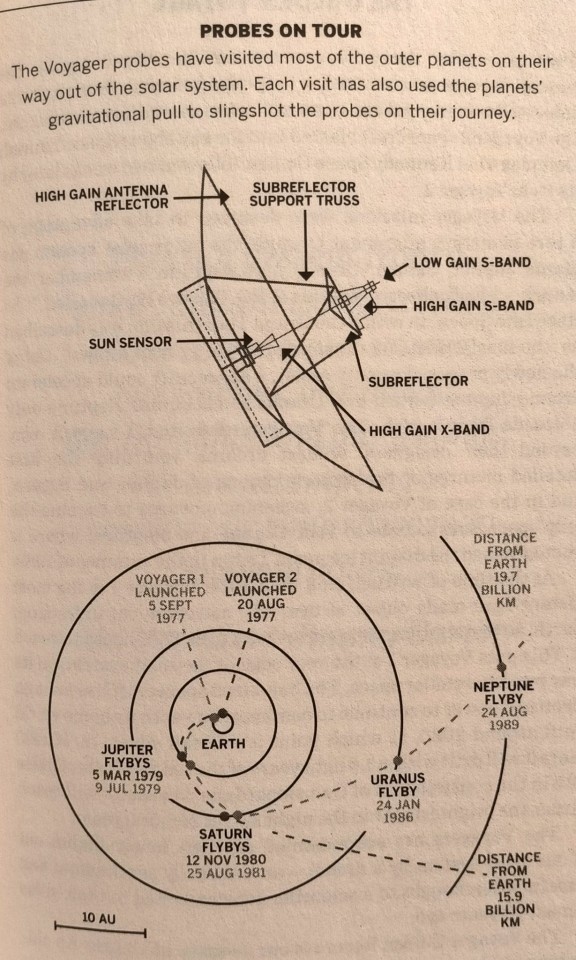
"Human Universe" - Professor Brian Cox and Andrew Cohen
#book quotes#human universe#brian cox#andrew cohen#nonfiction#voyager 1#voyager 2#probes#jupiter#saturn#uranus#neptune#gas giants#solar system#space exploration
22 notes
·
View notes
Text

Made myself a solar system necklace. Might make matching earrings at some point. Unsure if I’m going to try to sell this one because I don’t know if I can get my hands on some of the components again. Kind of a miss frizzle vibe
#a quality post by me#solar system#planet#astronomy#meteor#handmade jewelry#necklace#bead jewelry#my face#miss frizzle#planet earth#mars#venus#Pluto#Neptune#Uranus#mercury#jupiter#saturn#gas giants#earth#redhead#freckles
10 notes
·
View notes
Photo

The Mellanoid Planetary System -- Home of the "Mellanoid Slime Worms”
(Star Trek fanon worldbuilding)
The Mellanoid-Sun is a G8V Main Sequence Star a little cooler, less luminous, and more metallic than The Sun (Sol).
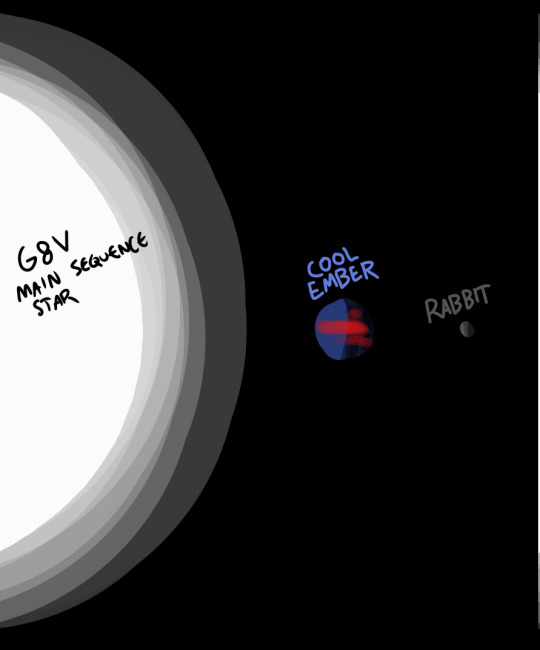
Orbiting close to the sun is Class-T hot Neptunian world, Cool Ember, which is so close to the Sun it is rarely seen except during afternoon, morning, and twilight. When seen through a telescope, it is sometimes blue and sometimes red, depending the orientation of its bright face. The sun-facing side is blue due to rayleigh scattering in its cloudless atmosphere and the night side is glowing a dull red due to heat from within the planet.
Very analogous to Mercury and the Inner Bajoran Planets is the Class-D planet Rabbit, a tidally locked cratered world. The far side is covered in ice. Its fast orbit has given it the name that could be vaguely translated as “Rabbit” (a sort of quick herbivorous vertebrate).
Rabbit is the largest member of an asteroid belt that extends out from Cool Ember to just under Omen’s orbit.

Beyond the inner planets is Omen. It is a “Class-J” gas giant of 2 Jupiter Masses which formed in the outer solar system and migrated inwards, disrupting the existing planet-forming disk. It has four substantial moons and about 15 minor satellites. It exists within the habitable zone, and its satellite planets are quite diverse. Rival is the innermost satellite planet, Class H and volcanic, followed by Lake, a Class O pelagic world, Spark, an airless Class D moonlike world, and Oldsky, a Class M habitable satellite planet.
Omen and Oldsky are also known in the Federation by their Zaldan names, Rarchilk and Ragdus, as prior to joining the Federation, the Zaldan Military operated an outpost and research station on Ragdus. Mellanoids sometimes refer to Oldsky as Ragdus, but they ALWAYS refer to Omen by that word.
Omen has a few asteroidal coorbital companions, but not very many, as the trojan population has been destabilized by a very large coorbital...

Omen’s largest coorbital companion is Mellanus, the M-class homeworld of Mellanoid Slimes (Such as Murph Prodigy & Eaurp Guz). Mellanus is very similar in radius to Earth, but it’s slightly less massive and lacks any major satellites. It does have two small asteroid satellites.
Mellanus’s shallowest oceans are covered in a thin layer of slime--but it’s enough that it actually makes up the majority of the planet’s biomass. Its forests and deserts are a little more conventional, with slime life uncommon in the deserts except for Mellanoid Slime People and reasonably common but not dominating in the forests.
Mellanus had its first contact with aliens in the 2320s or 2330s, via the Zaldans. Mellanus’ Fed-standard name comes from the Zaldans. When they Zaldans joined the Federation, they cut contact with Mellanus as they were pre-warp, and abandoned their outpost on Ragdus.
Mellanus invented their own warp drive in the 2360s, and were fast-tracked into the Federation for political reasons during the Dominion War, as it was feared they might otherwise be manipulated by the changelings.
Mellanus has successfully lobbied to resist Starfleet interference in their space affairs, and, with nuclear fission, chemical propulsion, and rudimentary impulse and warp drives, are focusing on exploring their own solar system before they “let starfleet have their fun.”
Mellanus is in a Horseshoe Orbit of Omen. Roughly every 18 Mellanus years, it makes a close approach to Omen in its orbit. Omen’s gravity pulls it into a higher orbit, then 18 years later they meet on the other side, and Omen’s gravity pulls it into a lower orbit. Omen got its name as, when it begins to get very large in the sky, it its a portent of a changing seasonal arrangement. In the low orbit, summers may be harsh and winters mild, and in the high orbit, summers mild and winters bitter.
Omen creates another season cycle as well, that of interest in astronomy and space exploration. For the whole time the Space Program has existed, every 18 years at each close approach of Omen, people are more and more willing to support the Space Program as it is a quite striking and visible reminder of how much space affects life on Mellanus.

Beyond Omen is a substantial gap where a few unstable asteroids orbit, analogous to the trojans of our solar system. Beyond that is Glerbuh, a proper name for an ancient deity of Time.
Glerbuh is a Class-J super-jupiter of about 4 Mj, with 13 small icy worlds (most either P-class or D-class), and over a hundred irregular captured satellites! With a telescope, if you carefully blot out the light of the planet itself, you will see a faint nebulousity surrounding the planet. This was first identified by an astronomer who was so skilled at shapeshifting they could manipulate their eyes into achromatic telescopes, and thus easily work with internal obstructions near the focal plane. (Mellanoid Slime Astronomers on a budget may dissolve their eye lenses or figure their eye lenses manually rather than use real eyepieces, but this approach has limitations). The cause of the nebulosity was suspected in the photographic era but it wasn't until early space probe missions that the cause was definitely determined: Almost all of Glerbuh's innermost rounded moons are cryovolcanically active, including a pair of horseshoe coorbitals, and they are spewing water ice from their internal oceans into space. This is potentially one of the most interesting and unique astrobiological environments--a system of moons swapping ice, water, and maybe even microbes, and would be worthy of exploration by Starfleet, except that Mellanus demands to continue its own space program.

Beyond Glerbuh are five ice giants. Four of them were known to Mellanoids prior to Federation membership, the other one was discovered using subspace sensors and orbits extremely far out, but is the most massive of them. They are 7, 11, 14, 5, and 18 Earth Masses respectively, and each have moon systems worthy of study. Only Two of the ice giants have yet been visited by robotic spacecraft, the first and third one. (The first was explored by a dedicated mission, the third one was a third flyby in an Omen-Glerbuh-Eauauh flyby chain) minor planets, comets, and full size planets are by convention named for their discoverer*, so the ice giants are named:
Glarpi
Shpler
Eauauh
Flibul
Schmidt (named for Captain Schmidt of the U.S.S. Courage, who first reported the planet--though it's probable the Zaldans knew of it first and never mentioned it in their pre-federation dealings with the Mellanoids.)
*When Glarpi was discovered, it was originally named Slarmock's Star, after an emperor. Needless to say, astronomers from other mellanoid nations of the time didn't take well to this name, and called it such things as the Demon Star, the Fool Star, or just, The Sixth Planet. Eventually it was referred to as Glarpi's Planet, or just Glarpi, and that was how it was. When someone discovers more than one object, it can either be given a name followed by a number, or the second object can be named after a friend of the discoverer, with certain rules established by the Mellanoid Astronomical Nomenclature Office regarding not naming it after politicians or especially controversial figures.

(Deep out in the far reaches of the Mellanus star system, where no spacecraft or starship have ever been, lies Schmitt, the last and heaviest ice giant. It was picked up on subspace sensors and later recovered by Mellanoid Astronomers using an orbiting space telescope. Nothing is known about it aside from its pinkish color and the fact that it has a very substantial moon for its size.)
#Mellanoid Slime Worm#slimegirl#astronomy#planets#space#space art#gas giants#ice giants#Star Trek#horseshoe orbit#worldbuilding#solar system
19 notes
·
View notes
Photo
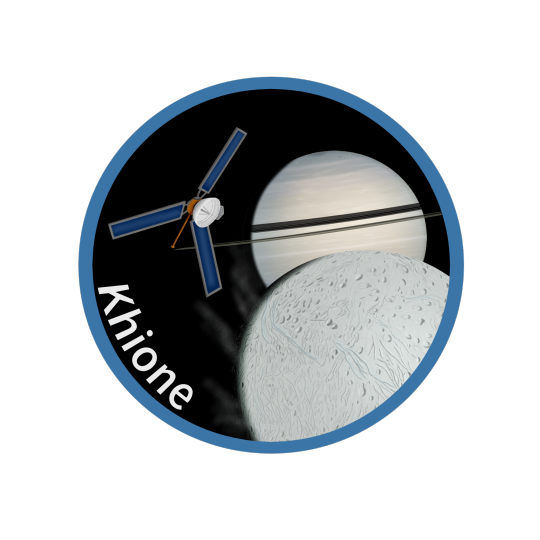
Hi! I don't tend to do these things, but I had a brief period of time where I completed this mission patch for a client. The patch depicts a their mission idea, which is a Stardust-like mission to Enceladus, where it would capture geyser ejecta and return it to Earth.
Just a slight update, I'm not sure how often I can do things like this anymore. It takes a lot out of me, despite its simplicity. I'll still try to do art when I can, but I think uploads will be very sporadic. Sorry about this!
Image ID will be in reblogs, since it’s a bit long!
#space art#space probe#accessible art#digital art#digital painting#saturn#enceladus#gas giant#NASA#CNSA#Roscosmos#space exploration#spacescape#planets#space#icy moon#gas giants#solar system#KSP#kerbal space program#probe#SETI#ESA#artists on tumblr
17 notes
·
View notes
Note
Hello Jupiter aspaceinnthecosmo I hope you’re having a splendid evening
I did an assignment in Fifth grade where we had to create an alien and mine lived on Jupiter yippee! Obviously that’s impractical but would you pls explain gas giants and like… their composition and why they exist and whatnot
hello kestrel spookykestrel (hm. that. doesnt quite work. i need to come up with some other nickname). my nights going pretty good! just finished ap physics homework :] i hope you're having a good night too!
anyways, to your question, lets start with the very basics: what is a gas giant?
gas giants are large planets with a molten core and layers of gasses (normally hydrogen and helium, although other gasses can be present) surrounding it. Most gas giants are at least 2-3x larger than the earth, and can become extremely massive.
okay, moving on:
(side note: what i'm explaining goes for most if not all gas giants in the universe, but i'm going to speak just about those in our solar system because we know most about them)
The way the gas giants got to be like this has to do with the formation of our solar system. In the beginning, gas giants were like all the other planets - chunks of rock and metal careening through the early solar system and gaining mass. The thing that marked them apart from the terrestrial planets, however, is that they formed beyond a certain point in our solar system called the Snow Line.
The snow line is the point a certain distance from a star beyond which water and other substances become solids. the planets that formed beyond this line had a lot more material to work with, so to speak, and this allowed them to gain a lot of mass quite quickly.
Once these early planets were massive enough, they started to attract gasses left over from the birth of the sun, forming a giant "blanket" of hydrogen and helium orbiting the core. The pressure from these gasses transformed the rocky core into a "soup" of liquid elements, and they become gas giants as we know them.
As for the composition of gas giants, they tend to be mostly hydrogen and helium - the most abundant elements in the universe. They can contain other elements, though these tend to be nearer the core.
before i end this post, i would like to make a distinction between the terms "gas giant" and "ice giant"
many of us think of all four of the outer planets as gas giants, and, although they're very similar, there is another term for planets like uranus and neptune - ice giants.
gas giants are planets such as saturn and jupiter - planets nearer the sun which consist of mostly hydrogen and helium. Ice giants such as Uranus and Neptune have the same formation process, but form farther out from the sun, in places where heavier gasses such as methane and carbon dioxide exist as ices, and form a large percentage of these planets' compositions. methane is what causes the blue color in both uranus and neptune, and is one of the main elements making up both planets.
hope this was what you wanted kes!
#aspaceinthecosmos#answered#kestrel#you have NO idea how hard it was not to make a 'in the beginning the universe was created' reference when i was talking about the#the beginning of the solar system#i had to have SO much self restraint#anyways#space#astronomy#planets#planetary science#gas giants#ice giants#jupiter#saturn#uranus#neptune
16 notes
·
View notes
